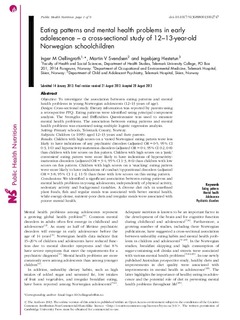| dc.contributor.author | Oellingrath, Inger Margaret | |
| dc.contributor.author | Svendsen, Martin Veel | |
| dc.contributor.author | Hestetun, Ingebjørg | |
| dc.date.accessioned | 2013-11-01T17:13:38Z | |
| dc.date.accessioned | 2017-04-20T06:12:49Z | |
| dc.date.available | 2013-11-01T17:13:38Z | |
| dc.date.available | 2017-04-20T06:12:49Z | |
| dc.date.issued | 2013-10 | |
| dc.identifier.citation | Oellingrath, I.M., Svendsen, M.V. & Hestetun, I. Eating patterns and mental health problems in early adolescence - a cross-sectional study of 12-13-year-old Norwegian schoolchildren. Public Health Nutrition 2013 | |
| dc.identifier.issn | 1368-9800 | |
| dc.identifier.uri | http://hdl.handle.net/11250/2439277 | |
| dc.description.abstract | OBJECTIVE: To investigate the association between eating patterns and mental health problems in young Norwegian adolescents (12–13 years of age). DESIGN: Cross-sectional study. Dietary information was reported by parents using a retrospective FFQ. Eating patterns were identified using principal component analysis. The Strengths and Difficulties Questionnaire was used to measure mental health problems. The association between eating patterns and mental health problems was examined using multiple logistic regression analysis. SETTING: Primary schools, Telemark County, Norway. SUBJECTS: Children (n 1095) aged 12–13 years and their parents. RESULTS: Children with high scores on a ‘varied Norwegian’ eating pattern were less likely to have indications of any psychiatric disorders (adjusted OR=0.5; 95% CI 0.3, 1.0) and hyperactivity-inattention disorders (adjusted OR=0.4; 95% CI 0.2, 0.8) than children with low scores on this pattern. Children with high scores on a ‘junk/ convenient’ eating pattern were more likely to have indications of hyperactivityinattention disorders (adjusted OR=3.4; 95% CI 1.3, 8,6) than children with low scores on this pattern. Children with high scores on a ‘snacking’ eating pattern were more likely to have indications of conduct/oppositional disorders (adjusted OR=3.8; 95% CI 1.2, 11.5) than those with low scores on this eating pattern. CONCLUSIONS: We identified a significant association between eating patterns and mental health problems in young adolescents, independently of physical activity, sedentary activity and background variables. A diverse diet rich in unrefined plant foods, fish and regular meals was associated with better mental health, while energy-dense, nutrient-poor diets and irregular meals were associated with poorer mental health. | |
| dc.language.iso | eng | |
| dc.publisher | Cambridge University Press | |
| dc.rights.uri | http://creativecommons.org/licenses/by-nc-sa/3.0/ | |
| dc.subject | eating patterns | |
| dc.subject | mental health | |
| dc.subject | adolescence | |
| dc.subject | psychiatric disorders | |
| dc.title | Eating patterns and mental health problems in early adolescence - a cross-sectional study of 12-13-year-old Norwegian schoolchildren | |
| dc.type | Journal article | |
| dc.type | Peer reviewed | |
| dc.description.version | Published version | |
| dc.rights.holder | © 2013 The Authors | |
| dc.subject.nsi | 811 | |
| dc.subject.nsi | 757 | |
| dc.identifier.doi | http://dx.doi.org/10.1017/S1368980013002747 | |

